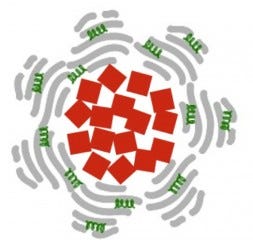February 25, 2015
Magnetic nanoparticles equipped with drugs could destroy blood clots 100 to 1000 times faster than traditional clot-busting technologies.
Kristopher Sturgis
|
Nanoparticle swathed in albumin and the anti-clotting agent tPA. |
When it comes to tracking and breaking up blood clots, time is of the essence. Researchers from Houston Methodist hope to address this issue with a new technique that infuses magnetic nanoparticles with drugs that are biochemically camouflaged, in an effort to find and destroy clots much faster than ever before.
The research, which has been tested using human blood and mouse clotting models, was developed to prevent many of the dangerous complications that arise from blood clots. From heart attacks and strokes, to pulmonary embolisms and severe tissue damage, blood clots are a major concern to countless patients every day. The technique was designed with nanoparticles in order to trap the drugs at the site of the clot, delivering a targeted dose of commonly used clot-busting drugs where they are needed most. The study was led by Paolo Decuzzi, PhD from Houston Methodist.
Decuzzi's team began by coating iron oxide nanoparticles in albumin, a protein found naturally in human blood. The albumin serves as the camouflaging agent, providing the loaded nanoparticles time to reach the site of the clot before the body's immune system can recognize the nanoparticles as invaders and attack them. The group chose iron oxide as the core because the researchers planned to use them with MRI techniques, along with remote guidance with external magnetic fields, and localized magnetic heating to further accelerate the process of clot dissolution.
Work with nanoparticles is becoming increasingly common in the medtech industry, as doctors and researchers look to take advantage of magnetically charged nanoparticles to target specific areas of the body. Last year, Google announced their intent to use nanoparticle technology as a potential disease detecting substance, with similar techniques that involve magnetically tracking the nanoparticles throughout the body.
As for the drugs infused in this technology, researchers have been working with tissue plasminogen activator (tPA), a commonly used clot-busting drug that can be found naturally in the blood in low concentrations. Normally, a small volume of tPA is injected into the patient's bloodstream where a confirmed or suspected clot is located. Then, some of the tPA reaches the clot, while much of it may continue past or around the clot, potentially ending up in the circulatory system.
Because much of the tPA can be lost into the circulatory system, doctors often are forced to inject a higher concentration of tPA, which can also increase the risk of hemorrhaging for the patient. Researchers believe that packing these magnetic nanoparticles with lower concentrations of tPA will not only reduce the risk of hemorrhaging, but also help trap the clot-busting drugs at the site of the clot, breaking it up faster and more efficiently than ever before.
Researchers began testing this new technique in a series of in vivo experiments, introducing blood clots to a mouse model before injecting the tPA-loaded nanoparticles into the bloodstream. They then used optical microscopy to follow the dissolution of clots, and compared to a control, found that the clots were destroyed roughly 100 times faster.
As for the future of the study, researchers will soon begin testing the safety of the nanoparticles, and their effectiveness in other animal models, with the goal of completing human clinical trials soon after. Decuzzi even plans to continue to examine the feasibility of using magnetic fields to manipulate and guide the nanoparticles toward clots in the body. And because these nanoparticles are covered in iron oxide -- a substance FDA is familiar with--and are comprised of substances already found naturally in the body, we might see this breakthrough clot-busting technology hit the market sooner than you might think.
Refresh your medical device industry knowledge at BIOMEDevice Boston, May 6-7, 2015. |
Kristopher Sturgis is a contributor to Qmed and MPMN.
Like what you're reading? Subscribe to our daily e-newsletter.
About the Author(s)
You May Also Like



